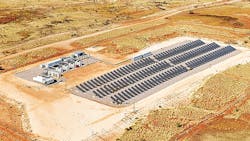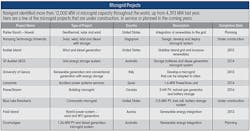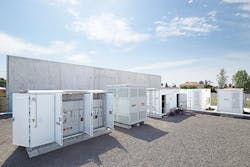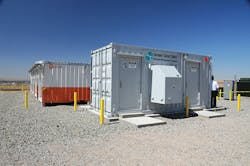Whenever there has been a problem with power delivery, the response has been to make the system bigger, to supersize it. It almost has been a mantra of bigger is better. These sacred words were chanted in every part of the grid: “There is no substitute for wire in the air.” As a result, the electric grid has become a gigantic maze of hubs, interconnection points and nodes connecting more remote centralized power plants to the customer, but this only has added to the issues.
Despite the continuation of these old-school practices, the electrical network has not improved. If anything, it has become more fragile and easier to shut down, which has led to a debate on decentralization of the network. The idea is to place generation closer to the load centers and enable the load centers to be sectionalized in times of crisis while still providing electrical power to the customer.
This sounds pretty complicated, but it is actually a dialogue about grid reliability and grid resiliency. The driving force behind this discussion is the issue of how to deal with prolonged power outages brought about by extreme weather conditions and issues such as grid security. At first glance, reliability and resiliency may seem like the same thing.
However, the distinction between these terms has generated a great deal of attention in the industry, with microgrid technology becoming the focus of the reliability-resiliency discussion.
Reliability and Resiliency
Reliability, as related to the power supply, is an electricity supply that is always available without limitations. Resiliency, as related to the power supply, is an electricity supply that can recover from adverse events quickly with minimal impact to the customer.
Interestingly, the consumer has been demanding appropriate enhancements be added to the network, but defining these enhancements has been challenging. How has the industry reacted to the not-in-my-backyard (NIMBY)-centered protesters gone global, which is known as build absolutely nothing anywhere near anybody (BANANA)? Well, noninvasive technology would be a good place to start, which is one reason microgrid technology has been gaining such attention.
A microgrid is unobtrusive and can be concealed in existing facilities. It is adaptable and can be modularized and sized to meet the needs of the application.
Dynamic Technology
The versatile microgrid really came to center stage after Superstorm Sandy. The technology seems to have become the focus of the reliability-resiliency discussion. Helping that dialogue is a recent report from the U.S. Department of
Energy (DOE), which listed severe weather as the No. 1 cause of power outages.
The DOE predicts, “The number of outages caused by severe weather is expected to rise as climate change increases the frequency and intensity of extreme weather events.” In
effect, this implies the problem is not going away and the solution must deal with it.
Microgrids have the capability of dynamic energy management along with the ability to protect critical loads, that is, resiliency. The rapid spread of distributed generation, such as rooftop photovoltaic (PV) installations, also has played a critical role in this decentralization undertaking. Many research groups say microgrids combined with distributed generation are fundamentally changing the way electricity distribution is taking place.
The old game-changer expression is constantly being used to describe the combination of microgrids with renewable generation and energy storage. This emphasis is shifting the grid concept from a centralized grid toward the development of a utility grid combined with localized grids — microgrids — that are self-sustaining miniature versions of the utility grid.
This has resulted in a slew of new microgrid applications for consumers ranging from individual facilities to large installations. Microgrid technology allows these facilities to be separate from the main grid and operate independently (that is, resilient). It also increases energy efficiency, ensures power stability and improves power quality (that is, reliable) when attached to the macrogrid.
These microgrids with the ability to interface with the larger grid have captured the attention of consumers, utilities and regulators alike. The fact a microgrid can operate in parallel to the utility grid, or can island itself when necessary, checks the boxes for both reliability and resiliency in the overall plan for making the grid more robust.
Transformation
Often after a catastrophic event such as Superstorm Sandy, there is a great deal of talk and no action. As time passes, so does the attention span, but this has not been the case with microgrid technology. A great deal of activity has taken place in the U.S. with programs and projects developed to harden the grid.
In Connecticut, the governor announced a statewide microgrid program to power public services and some businesses in the event of widespread outages on the power grid.
New York also announced big plans for microgrids in the state and has since become the leader of Northeastern states in incorporating microgrids into the utility grid. It currently has 75 installations, both planned and operational, totaling about 200 MW of capacity at last count and more coming.
New Jersey also was hard hit by Sandy. It announced a $200 million energy resiliency program with microgrids and distributed generation for the state.
The federal government has been busy, too. The DOE announced a wide range of microgrid activities with both regional and state partnerships to improve the resiliency of cities and towns during extreme weather events and other potential electricity disruptions.
“Building in grid resiliency has gained greater urgency in recent years, as demonstrated by the economic and personal losses from electricity outages due to severe weather,” said Energy Secretary Ernest Moniz. “Keeping the power on during extreme weather events and other electric grid disruptions is essential, particularly so that critical facilities such as hospitals and water treatment plants can continue operating.”
Various Sizes
One of the most successful microgrid adaptations to date has been the combined heat and power (CHP) technology. It is one of those new-yet-old categories of technology. Edison used this feature at his Pearl Street station. He provided heat from the steam generators to the buildings around the facility.
Today, DOE estimates the U.S. currently has about 4,100 CHP facilities in service. These facilities have a combined generation capacity of roughly 8 GW. The DOE also pointed out there are approximately 200 multifamily housing communities in the CHP database, so this technology is versatile.
The addition of PV, distributed wind, fuel cells and natural gas generation has redefined what size microgrid is cost-effective. Because of such a wide selection of generation, microgrids can be supplied in a wide variety of sizes, ranging from a few hundred kilowatts to multi-megawatt applications.
Generally, residential-sized microgrids serving one family or perhaps a neighborhood is usually less than 50 kW but could go up to 1 MW or 2 MW. Small industrial microgrids are commonly rated more than 200 kW, but less than 5 MW. Utilities have been working on feeder microgrids ranging from 5 MW to 20 MW. The substation microgrid is typically larger than 20 MW. Rural microgrids come in various sizes defined by what the end user needs.
Marble Bar, Australia, is a good example of a small microgrid helping a remote community to take advantage of a rich renewable source. Marble Bar has a 300-kW PV-powered plant that was added to existing diesel generators to form a microgrid. The intermittent energy provided by 2,000 single-axis solar modules is stabilized by ABB’s PowerStore kinetic flywheel grid-stabilizing technology, while the microgrid system is controlled by ABB’s Microgrid Plus networked control system. Together, these technologies enable peak penetration of renewable-generated energy of 85%. On average, 60% of the energy demand of Marble Bar is being supplied by solar energy, which displaces about 400,000 liters of fuel a year, equivalent to 1,100 metric tons of greenhouse gas emissions.
Mix and Match
PowerStream, a community-owned energy firm, has launched a hybrid microgrid demonstration project at its headquarters in Vaughan, Ontario, Canada, with GE. The project will include a 1.8-kW wind turbine, 17 kW of PV solar panels and a 35-kW natural-gas-fueled generator with storage. The storage includes a 23-kW lead-acid battery, a 12-kW lithium-ion battery and a 6-kW sodium-chloride battery.
GE is providing its Grid IQ Microgrid Control System as well as all necessary engineering design services. GE also will include its Durathon battery technology for the microgrid. The microgrid control system will monitor, track and forecast loads, generation and storage devices. This system will provide PowerStream’s headquarters with lighting, air conditioning and electric vehicle charging while allowing PowerStream to gain valuable microgrid operating experience in a controlled setting.
A really challenging microgrid configuration came out of Antarctica at the Ross Island research station a few years ago. This is a very remote location and it is an extremely environmentally sensitive area. The New Zealand Antarctic Institute and Meridian Energy Ltd. wanted to reduce the reliance of the Scott Base and McMurdo station on diesel-generated electricity, so it planned to install three 330-kW wind generators.
The wind generators would feed both research facilities. Backup diesel generation would still be needed, but it was estimated the wind turbines would reduce the carbon-dioxide emissions by about 1,242 metric tons per year.
ABB was selected to provide a microgrid solution for this project. One of the criteria for the microgrid was the ability of the wind farm to provide electricity to both research facilities. The diesel generation also had to be able to back up each facility, but there was a catch — the power systems of the two research stations operated at different frequencies. The New Zealand system operated at 50 Hz (cycles per second) and the U.S. system operated at 60 Hz. Another critical challenge was to eliminate the intermittency and variability of the wind generation.
The first challenge was answered with a frequency converter. ABB built this device into the microgrid system, allowing the two asynchronous (50-Hz and 60-Hz) power systems to be coupled together. This enabled the systems to operate in tandem, passing power in either direction.
The second challenge — intermittency and variability brought about by the wind generation — was addressed by ABB’s PowerStore grid-stabilizing flywheel system. This
device is a flywheel rated at 500 kW that manages power fluctuations by power injection or by absorption.
The entire system is controlled by ABB’s Microgrid Plus, which monitors the wind turbines, diesel generators, loads and flywheel energy storage device. The controller matches the loads with the most economical configurations of generator sets. It also smooths out surges and optimizes flow control within the isolated networks.
They Think Big in Texas
Utilities are getting involved with microgrids, too. It is no longer a customer-side-of-the-meter phenomena, but no utility has taken the plunge quite like Oncor, based in Dallas, Texas. Oncor has seen how the emerging energy storage and control systems can better enable microgrids, so it was only natural for the utility to construct its own microgrid application to get some operational experience.
What makes the Oncor microgrid unique is its topology. In April 2015, Oncor announced it had installed a new concept in microgrids on its system. It is a clustered microgrid, actually with four separate microgrids integrated to work together. The four individual microgrids can perform as one operating microgrid or individual microgrids operating in parallel, in tandem, or with the Oncor grid. The choice is dependent on the system conditions.
Oncor selected S&C Electric Co. and Schneider Electric to design and build its microgrid. Other partners included ABB, Kyocera, Princeton Power Systems, SMA Solar Technology and Tesla.
The interconnected microgrids have nine different distributed generation resources — including 104-kW PV arrays, a 65-kW gas microturbine, one 200-kW stationary battery, a 25-kW community battery, a 200-kW diesel generator, two 175-kW diesel generators and a 45-kW propane generator — for a total peak capacity of 989 kW upon loss of grid power in emergencies, plus the Oncor grid for power selection in non-emergency operations. The microgrid is a combination of S&C’s advanced distribution automation equipment and Schneider Electric’s Microgrid Controller along with its StruxureWare Demand-Side Operation technology.
The system uses high-speed communications and distributed grid intelligence to determine the most efficient use of power resources and to guarantee power to critical site operations in the event of an extended grid outage. The energy storage portion of the system can take power from the Oncor grid or the facility’s generation resources.
Interestingly, one of the batteries is manufactured by Tesla Motors and the other by S&C. This style of microgrid is located on the customer’s side of the meter, but Oncor happens to be the customer. Oncor will explore how similar microgrids and services could be provided or supported by the utility for other critical infrastructures such as hospitals, 911 dispatch centers and computer centers.
Microgrid Variety
Microgrid technology is being adapted in ways never thought of when developers started deploying pilot projects to prove the concept. The Ross Island microgrid took grid stabilization to a new level with a flywheel smoothing out the wind-generated power while using a frequency converter to enable the microgrid to feed two asynchronous power systems.
One innovative application was the combining of one fuel-based generator with one renewable energy generator to form hybrid microgrids. That has been surpassed with microgrid projects like Oncor’s mix of multiple-fueled generators and energy storage with PV.
These project and others being developed are proving the concept of public-purpose microgrids. These clustered microgrids can function like building blocks. Under normal conditions, they can operate in parallel to the utility grid. When an unexpected event takes place such as a feeder problem, they can be independent of the grid and each other. In the event of a much larger event such as a storm, they can operate in larger combinations to meet the needs of the community.
Microgrids are changing the business models for industry and for utilities. Of course, it could be expensive and, in many cases, disruptive, but the shift to this old-yet-new technology is inevitable and a trend the industry cannot afford to sit back and watch. Besides, the challenge is too much fun to ignore.
About the Author
Gene Wolf
Technical Editor
Gene Wolf has been designing and building substations and other high technology facilities for over 32 years. He received his BSEE from Wichita State University. He received his MSEE from New Mexico State University. He is a registered professional engineer in the states of California and New Mexico. He started his career as a substation engineer for Kansas Gas and Electric, retired as the Principal Engineer of Stations for Public Service Company of New Mexico recently, and founded Lone Wolf Engineering, LLC an engineering consulting company.
Gene is widely recognized as a technical leader in the electric power industry. Gene is a fellow of the IEEE. He is the former Chairman of the IEEE PES T&D Committee. He has held the position of the Chairman of the HVDC & FACTS Subcommittee and membership in many T&D working groups. Gene is also active in renewable energy. He sponsored the formation of the “Integration of Renewable Energy into the Transmission & Distribution Grids” subcommittee and the “Intelligent Grid Transmission and Distribution” subcommittee within the Transmission and Distribution committee.



